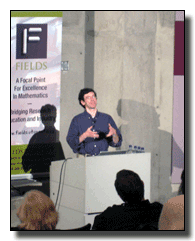Social Network/ing Week at the University of Toronto kicked off tonight with a fascinating keynote by Cornell’s Jon Kleinberg.  ‘The Geography of Social and Information Networks,’ was one of the most fascinating applied mathematical lectures I can say to having ever attended (and before I go too far I will stress that the math was made very, very approachable for a layperson such as myself). His introducer indicated that he invented algorithmic sociology and although this sounded rather presumptuous (an Al Gore and the Internet sort of thing?), I can’t help but be quite willing to give this some credence after listening to this presentation.
‘The Geography of Social and Information Networks,’ was one of the most fascinating applied mathematical lectures I can say to having ever attended (and before I go too far I will stress that the math was made very, very approachable for a layperson such as myself). His introducer indicated that he invented algorithmic sociology and although this sounded rather presumptuous (an Al Gore and the Internet sort of thing?), I can’t help but be quite willing to give this some credence after listening to this presentation.
Kleinberg opened with a quote from Jim Gray, that “the emergence of cyberspace and the world wide web was like the discovery of a new continent.” Kleinberg was quite deliberate in this juxtaposition of the geographic with the technological and he then teased this into a further merge with the social. But he questioned whether maps are actually an appropriate metaphor for something as physical as social networks – but chose to let this stand on the need to have some common vocabulary with which to be able to relate.
Kleinberg considered the evolution from Milgram’s Small World Experiment of 1968, through the more recent Watts and Strogatz’s work with the MSN network which attempted a more algorithmic approach, but largely substantiated the earlier work. Kleinberg’s own work with LiveJournal attempted to introduce less randomness to the hypothesis and move away from simple closeness to a ranked approach that has applications to the spread of epidemics.
The real meat of the talk was in the conclusion (and I think that this has now been thrown out there for the rest of the conference to further discuss). No one is questioning that social networks exist and have existed throughout time. Nor are we questioning that technologies have enabled new and potentially more effective forms of communication. What is really quite stunning, and paradigm-shifting is that these networks are now made visible. He quoted himself from an interview in the Globe and Mail in which he claimed that “MySpace is awkward because it makes visible the invisible. It makes public what should be private. It doesn’t just create social networks, it anatomizes them and spreads them out like a digestive tract on the autopsy table so that you can see what is connected to what and who is connected to whom.” And this is where I suddenly clued in. The network isn’t new, but the fact that it is now made visible and that this can then have an impact on how it is constructed and functions is radically new. The network then becomes the object and self-reflective. Soon he posits, software will know more about you then you know about yourself and not only does this demand a need for better computational models to analyse the network, but more importantly we will learn a lot more about large populations and about individual behaviour raising huge concerns about institutionalized lack of privacy.
